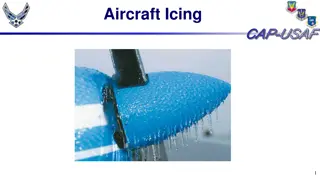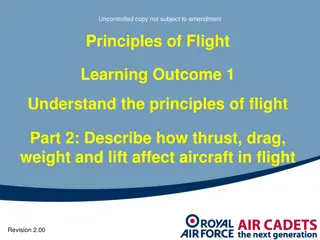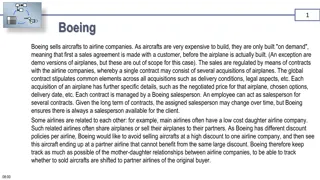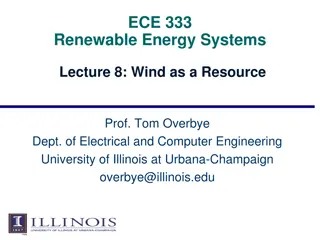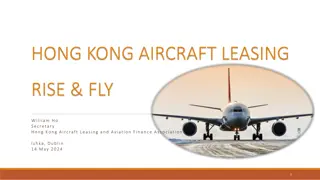Understanding Wind Effects on Aircraft Turn-back Maneuvers
Exploring the impact of wind on turn-back maneuvers after a single-engine failure during takeoff. Discusses the relationship between aircraft track, altitude loss, and key parameters such as wind velocity, bank angles, and TAS. Key factors affecting segment 3 of the maneuver are highlighted.
Download Presentation

Please find below an Image/Link to download the presentation.
The content on the website is provided AS IS for your information and personal use only. It may not be sold, licensed, or shared on other websites without obtaining consent from the author. Download presentation by click this link. If you encounter any issues during the download, it is possible that the publisher has removed the file from their server.
E N D
Presentation Transcript
Single-Engine Failure After Takeoff: The Anatomy of a Turn-back Maneuver Part 4 Les Glatt, Ph.D. ATP/CFI-AI VNY FSDO FAASTeam Representative lgtech@roadrunner.com (818) 414-6890 Checked Out From The SAFE Members Only Resource Center Society of Aviation and Flight Educators www.safepilots.org 1
How Does Wind Affect the Turn- back Maneuver? 2
Aircraft Gliding Under Horizontal Wind Conditions Headwind Case Tailwind Case V** VV V VV V V ** VH G VH VW G VW VG = VH + VW VG = VH - VW 4
How Does Wind Affect Turn-back Maneuver? Relationship exists between the climb/glide angle of the aircraft relative to the air mass and relative to that of the earth V Sin V = Rate of Descent Does Not Change Sin g g where V = True airspeed VG = Ground speed = Climb/glide path angle relative to air mass G = Climb/glide path angle relative to earth Sin V G= ( Sin ) V G 5
What are the Parameters that Affect the Aircraft Track and Altitude Loss in a Turn-back Maneuver in the Presence of a Horizontal Wind? 6
Key Parameters that Affect Aircraft Track and Altitude Loss in Turn-back Maneuver VW Ratio of wind velocity to the TAS - V Wind direction relative to the runway heading Radius of turn in segment 1 relative to the air mass TAS V1 Bank angle Radius of turn in segment 3 relative to the air mass TAS V2 Bank Angle During the wings-level glide we will not take advantage of the fact that we can shallow the glide angle slightly by decreasing the TAS when flying in a tailwind 7
Effect of Horizontal Wind on Segment 3 Track Segment 3 will need to be flown with a variable bank angle in order to roll out on the runway centerline Groundspeed of aircraft is changing in segment 3 8
Model Simulations of a C-172 Turn-back Maneuver in the Presence of a Wind 9
Examples of Wind Effects on Aircraft Track and Altitude Loss During a Turn-back Maneuver (Gross Weight and Sea Level Conditions) Case 1 Wind speed 10 kts Wind direction 0 degrees relative to the runway heading Case 2 Wind speed 10 kts Wind direction 45 degrees to the left of the runway heading Case 3 Wind speed 10 kts Wind direction 90 degrees to the left of the runway heading Compare these results to the no wind case 10
Effect of Wind on the Aircraft Track During a Turn- back Maneuver Aircraft tracks are results of actual simulation of turn- around maneuver Equations programmed in a Excel Chart form Can vary parameters on the fly and look at Altitude loss in each of the 3 segments Aircraft ground track during the turn-back maneuver 11
Effect of Wind on the Aircraft Track During a Turn- back Maneuver Simulation is programmed as follows Specify distance from DER Aircraft rolls into a 45 degree bank at airspeed V1 Aircraft rolls wings level when either Nose of aircraft is pointing at DER with no wind Ground track of the aircraft tracks directly toward DER Segment 2 flown at V2 Segment 3 flown with a 15 degree bank angle at V2 but with a radius of the turn based on V2 + VW 12
Effect of Wind on Turn-back Maneuver Started at 2640 feet From DER (Gross Weight, Sea Level, 10 Kt Wind) VW_10_90 800 VW_10_45 400 0 VW_10_0 0 200 400 600 -400 -800 VW /V = 0.15 -1200 -1600 -2000 -2400 DER -2800 13
Effect of Wind on Turn-back Maneuver Started at 2640 feet from DER (Cont.) 800 VW_10_90 400 VW_0 VW_10_45 0 -500 0 500 VW_10_0 -400 VW /V = 0.15 -800 -1200 -1600 -2000 -2400 DER -2800 14
Effect of Wind on Turn-back Maneuver Started at 2640 feet from DER (Cont.) 800 VW_10_90 400 VW_0 VW_10_45 VW_10_0 0 -500 0 500 VW_10_0 -400 VW /V = 0.15 -800 -1200 -1600 -2000 -2400 -2800 15
Effect of Wind on Turn-back Maneuver Started at 2640 feet from DER (Cont.) 800 VW_10_90 VW_0 400 VW_10_45 VW_10_0 0 -500 0 500 VW_10_45 VW_10_0 -400 VW /V = 0.15 -800 -1200 -1600 -2000 -2400 -2800 16
Effect of Wind on Turn-back Maneuver Started at 2640 feet from DER (Cont.) VW_10_90 800 VW_0 400 VW_10_45 VW_10_0 0 VW_10_45 -500 0 500 VW_10_0 -400 VW_10_90 VW /V = 0.15 -800 -1200 -1600 -2000 -2400 -2800 17
Effect of Wind on Turn-back Maneuver Started at 2640 feet from DER (Cont.) VW_10_90 800 VW_0 400 VW_10_45 VW_10_0 0 VW_10_45 -500 0 500 VW_10_0 -400 VW_10_90 VW /V = 0.15 -800 -1200 Altitude Loss VW_0_0 542 ft VW_10_0 501 ft VW_10_45 473 ft VW_10_90 494 ft -1600 -2000 -2400 -2800 18
Effect of 10 Kt Headwind on Required Runway Length for C- 172 During Turn-back Maneuver (Gross Weight at Sea Level) 5500 5000 Minimum Runway Length Required (ft) No Wind Case 4500 4000 3500 3000 2500 10 Kt Headwind 2000 1500 Region of Impossible turn 1000 500 0 0 1000 2000 3000 4000 5000 6000 7000 Distance From DER (ft) 19
Effect of 10 Kt Headwind on Required Runway Length for a C-172 During Turn-back Maneuver (Gross Weight at Sea Level) 5500 5000 Minimum Runway Length Required (ft) No Wind Case 4500 4000 3500 80 ft of Excess Altitude to Dissipate 3000 2500 10 Kt Headwind 2000 1500 Region of Impossible turn 1000 500 0 0 1000 2000 3000 4000 5000 6000 7000 Distance From DER (ft) 20
Understanding the 10 Kt Wind Case No wind case conditions Climb angle = 5.25 degs Wings-level glide path angle = 6.3 degs 10 Kt headwind case Climb angle =6.1 degs Wings-level glide path angle = 5.5 degs At large distances from the DER altitude loss is dominated by the wings-level glide distance Aircraft gains more altitude on the upwind leg (climb) than it loses on the downwind leg (glide) 21
Headwind Effect On Height Above DER (Gross Weight, Sea Level, 10 Kt Headwind) 1100 1000 10 Kt Headwind FPA = 6.1 deg 900 800 Height Above DER (ft) 700 600 No Wind FPA =5.25 deg 500 400 300 200 100 0 0 1000 2000 3000 4000 5000 6000 7000 8000 9000 10000 Runway Length (ft) 22 *
Effect of Headwind on Keyhole Turn-back Scenario 10 Kt headwind case Required runway length reduced by about 14% 6000-7700 feet 23
How to Modify the Results to Account for Changes in the Model Assumptions If we increment the altitude loss by h Aircraft must attain this increment over the runway The additional runway length, L required to achieve this altitude increment h is given by h L where Tan = G is the climb angle G This additional length is added to the values shown in the previous charts to obtained the updated charts for the new model assumptions Safety factors can be applied to the altitude loss in the turn-back in order to compensate for pilot skills in executing the maneuver 24 *
Summary of What We Have Learned about Turn-back Maneuvers Teardrop turn-back maneuver Performed on upwind leg after departure Requires minimum amount of altitude loss compared to other types of turn-back maneuvers A region of impossible turn-back exists close to the DER which can be reduced if the aircraft has either excess altitude or a bank angle steeper than 15 degrees is utilized close to the ground Bank angle in segment 3 is limited by airspeed in segment 2 (V2) in order to prevent aircraft from entering an accelerated stall Required runway lengths are considerably less than that required with a racetrack or keyhole turn-back maneuver C-172 under no wind conditions requires a 5300 foot runway 25
Summary of What We Have Learned about Turn-back Maneuvers (Cont.) Keyhole/Racetrack turn-back maneuver Can be performed either upwind or over the runway Avoids any region of impossible turn-back close in to the DER Requires considerably longer runways than the teardrop turn- back maneuver C-172 requires somewhere between 7100-8300 foot runways for racetrack turn-back scenario and slightly longer runways for keyhole scenarios 26
Summary of What We Have Learned about Turn-back Maneuvers (Cont.) Aerodynamics of the turn-back maneuver Glide path angle directly proportional to the load factor and inversely proportional to the L/D ratio V1 airspeed for segments 1 and 3 contains a 10% safety factor above the accelerated stall speed for the weight of the aircraft Bank angle for segment 1 should be flown at 45 degrees to minimize the altitude loss in the turn (however 40 degrees can be utilized with very little impact on the altitude loss) Wing-level glide should be flown at speed for maximum L/D at the weight of the aircraft Airspeed for segment 3 should be flown at speed for maximum L/D (same speed as in segment 2) 27
Summary of What We Have Learned about Turn-back Maneuvers (Cont.) Take-off/climb profile Perform short-field over an obstacle take-off (VX) Accelerate from VX to V* (V1 +10 Kts for C-172) Climb out at V* 28
Summary of What We Have Learned about Turn-back Maneuvers (Cont.) When engine failure/malfunction occurs and you have committed to initiating a turn-back maneuver Lower the nose of aircraft to the horizon and attain V1 before initiating 45 degree banked turn Roll out wings-level and track directly to DER for the teardrop turn-back maneuver using the airspeed for maximum L/D at aircraft weight Make final turn using shallow 15 degree bank angle (lead turn) Dissipate any altitude by turning the aircraft toward the centerline of the runway and S-Turn across the centerline to lose altitude 29
Summary of What We Have Learned about Turn-back Maneuvers (Cont.) Wind effects Always perform a turn-back into the crosswind Expect the climb angle on the upwind leg to increase and the glide angle coming back to decrease How much increase/decrease depends on wind direction and the wind velocity ratio VW /V The presence of a wind (no tailwind component) will always reduce the required runway lengths when compared to the no wind case No wind case could be used as a conservative estimate when taking off into a wind 30
Summary of What We Have Learned about Turn-back Maneuvers (Cont.) Use required runway length chart for risk reduction and decision making prior to departure If required runway length is greater than the airport runway length Do not perform a turn-back maneuver If required runway length is less than the airport runway length Only commit to a turn-back if the aircraft height over the DER is at or above the value in the HLchart If obstacles penetrate the footprint of the turn-back maneuver Don t attempt a turn-back maneuver Required runway lengths for the turn-back can be easily adjusted using safety factors to account for pilot skills in executing the maneuver 31 *
As I Stated at the Beginning of the Seminar The Devil is in the Details 32 *
REMEMBER! If You Make the Decision to Turn-back: The Runway Length Chart is Based on the Planned Teardrop Turn-back Maneuver Execute the Plan and Modify it only to Dissipate Altitude 33 *
In a No Wind Condition, Which Runway Configuration Requires the Least Altitude for the Turn-back Maneuver? Case 1 Case 2 Case 3 L L L Take-off Direction D Parallel Runways Characterized by Length L and Separation Distance D Intersecting Runways Characterized by Length L and Angle Single Runway Characterized by Length L 35
Now Go Back and Review the Dave Keller Video Analyze the video and audio Consider the following conditions in your review Airport elevation and surface temperature (density altitude) Surface wind (AOPA video 2:36:14-16 to observe segmented circle and wind sock) Length of runway aircraft departed Aircraft weight compared to gross weight Airspeed used for the turn-back (what should V1 have been?) Was the engine shut down or left idling (effect on L/D ratio)? Altitude above the surface when the engine malfunctioned Distance from the runway when the engine malfunctioned Turn-back maneuver he actually flew Where he landed on the runway 36
Based on the Video/Audio from the AOPA Website and What you Learned this Evening: What Percentage of Skill and Luck Do You Believe was Involved in Executing this Successful Turn-back Maneuver? 37
FAA Customer Feedback http://www.faa.gov/about/office_org/headquarters_offices/avs/offices/afs/qms/ Karla Borden, VNY FSDO FAA Safety Team Program Manager 38





